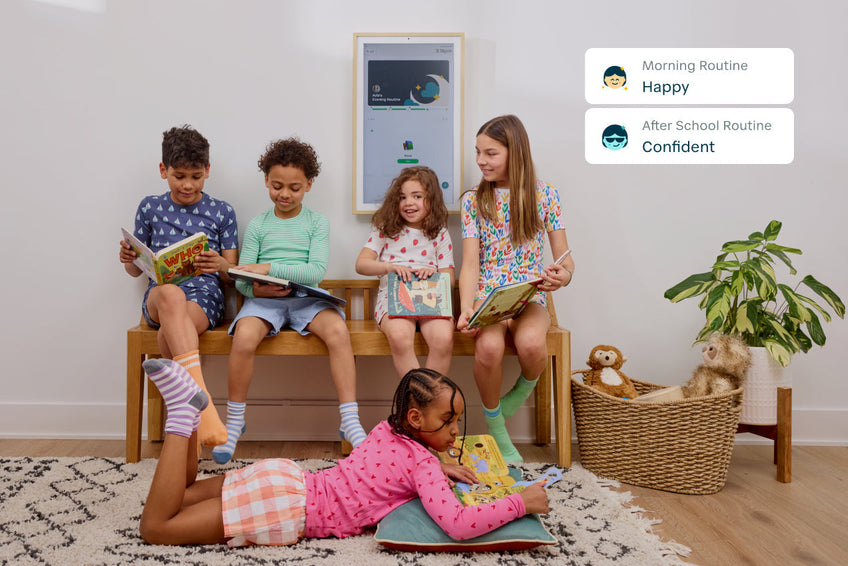Creating a consistent after-school routine for your child is one of the most effective ways to foster independence, reduce stress, and ensure that responsibilities are managed smoothly. After a long school day, children need structure to transition from school to home life, helping them balance homework, chores, playtime, and relaxation. By implementing a predictable routine, your child will know what to expect each day, which encourages responsibility and self-management.
Here’s how you can set up an effective after-school routine for your school-age child:
1. Establish a Transition Period
After a busy day at school, most kids need time to decompress before diving into homework or household tasks. A dedicated transition period, typically lasting 15-30 minutes, gives children a chance to relax and reset. This can be the first step in your child's Hearth routine.
This transition could include having a snack, spending some time outdoors, or doing a quiet activity like reading. By creating a buffer between school and their after-school responsibilities, you help your child ease into the rest of their day with less resistance.
2. Schedule Focused Homework Time
Homework is a critical part of most children’s after-school routine. Instead of leaving it until the last minute, set a dedicated time for homework when your child is most alert but has had a chance to unwind. This time block will help your child get into the habit of completing their assignments regularly and without procrastination.
It’s also helpful to ensure your child’s study space is prepared ahead of time, with all the necessary supplies easily accessible. Creating a calm and organized environment can make homework time more productive and less stressful.
3. Include Chores and Responsibilities
Assigning age-appropriate chores is a great way to teach responsibility and build independence. When kids contribute to the household through small, manageable tasks, they develop a sense of ownership and pride in their role within the family.
Chores can include tasks like feeding pets, tidying their room, taking out the trash, or helping with dinner prep. To ensure the routine stays fresh and engaging, you can rotate chores weekly so your child gets to learn new skills and doesn’t become bored with repetitive tasks.
4. Make Time for Play and Hobbies
While school and chores are important, it’s equally crucial to allow time for play and personal interests. After the structured parts of the routine, give your child space to engage in activities that bring them joy, whether that’s playing outside, doing a creative project, or practicing a hobby.
This downtime is essential for children’s mental health and well-being. It allows them to unwind, explore their interests, and build confidence in their abilities. Whether it’s free play or a structured hobby like sports or music, this time should be part of their daily routine.
5. Customize the Routine for Your Child
Every child is different, and their routine should reflect their unique needs, energy levels, and schedules. While some children might need longer transition times, others might prefer diving straight into homework or chores. Take the time to observe how your child responds to various activities, and customize the routine to best suit their personality and lifestyle.
If your child has extracurricular activities like sports, music lessons, or clubs, make sure to adjust the after-school routine accordingly. Some days might be more structured, while others might allow for more free time.
Involving your child in the routine planning process is also key. When children have a say in their daily activities, they feel more empowered to take ownership of their routine. By giving them options and asking for their input, you encourage them to engage with the schedule more positively.
6. Foster Independence and Responsibility
One of the biggest benefits of a structured after-school routine is that it helps children develop independence. When they know what’s expected of them and have the tools to manage their time, they become more self-sufficient and confident in their ability to handle responsibilities.
Providing visual cues and consistent expectations reinforces these lessons, helping your child understand the importance of completing tasks without constant supervision. Over time, as they master each element of the routine, you can gradually introduce new responsibilities, giving them more opportunities to build self-reliance.
Conclusion
Setting up an after-school routine for your child doesn’t just bring structure and order to your household—it also teaches your child valuable life skills like time management, responsibility, and independence. A well-designed routine helps your child understand what’s expected of them and gives them the tools to succeed both in school and at home.
By incorporating transition periods, focused homework time, chores, play, and a consistent evening routine, you can create a daily schedule that supports your child’s growth and development. Over time, this routine will foster a sense of independence and confidence, setting your child up for success as they navigate both their school years and the life skills they’ll carry into adulthood.




